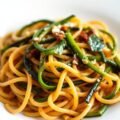Let’s talk indulgence. Nigella’s Duck Legs and Potatoes isn’t just dinner. it’s a love letter to slow cooking, crisp edges and unapologetic comfort food. It’s the kind of dish that makes your kitchen smell like a cozy tavern and makes you wonder why you ever thought chicken was exciting.
This dish is classic Nigella: deceptively simple, deeply flavorful and a little bit decadent. Four duck legs, nestled in a tray of potatoes, roasting together until everything’s golden, crisped and bathed in the duck’s own glorious fat. There are no fussy sauces or garnish drama here. It’s all about fat as flavor, patience as technique and the kind of cooking that makes you want to sit back with a big glass of red and not answer your phone for the rest of the evening.
The first time I made this, I was skeptical. How could something so straightforward-five or six ingredients max-end up tasting like something you’d get at a countryside auberge? But trust me, this recipe walks that fine line between minimal effort and maximum payoff. You just have to let it do its thing. No micro-managing.
Nigella Duck Legs And Potatoes Recipe
Ingredients Needed

Now, Nigella doesn’t go in for long lists. Here’s what you’ll need:
- Duck legs – 4 of them. Bone-in, skin-on. You want those bad boys to render out their fat and crisp like dreams.
- Potatoes – Waxy varieties like Charlotte or Yukon Gold are your best bet. You need about 1.5-2 lbs.
- Garlic – A whole head, cloves separated but left in their skins. Trust me, they go caramelized and sweet in that duck fat.
- Fresh thyme – A few sprigs. It adds that whiff of herbaceousness without overpowering the dish.
- Salt and pepper – Don’t underestimate the magic of a good seasoning.
- Optional: Red pepper flakes or lemon zest for a little zing. Not traditional but I sometimes sneak them in when I’m feeling bold.
That’s it. No broth. No butter. Just duck fat and its alchemy.
Equipment Needed
This is a low-tech, high-reward kind of situation. You don’t need fancy gadgets but here’s what helps:
- Roasting tray – Large enough to hold the duck legs and potatoes in a single layer. Crowding is the enemy of crisp.
- Sharp knife – For slicing those potatoes evenly.
- Tongs or spatula – To flip things around once in a while.
- Oven – Because, obviously.
I use my old, slightly warped enamel roasting tray that’s seen better days. But that’s part of the charm. it catches all the good bits.
Instructions To Make Nigella Lawson’s Duck Legs And Potatoes
1. Prep the Duck
Start by scoring the skin of the duck legs lightly. just a few shallow cuts across the surface. This helps the fat render out more evenly. Season them generously with salt and pepper. Let them sit while you deal with the potatoes.
2. Slice the Potatoes
Cut your potatoes into thick slices. about ½ inch. You don’t want them too thin; they need to hold up during the long roast. Scatter them across the roasting tray.
3. Add Garlic and Thyme
Toss in the garlic cloves (still in their skins!) and a few sprigs of thyme among the potatoes. It’s already smelling good and nothing’s even cooking yet.
4. Lay the Duck Legs on Top
Place the duck legs skin-side up on top of the potatoes. No oil needed. You’re about to witness the miracle of duck fat.
5. Roast Low and Slow
Slide the tray into a preheated oven at 300°F (150°C). Let it roast for about 2 hours. Every 45 minutes or so, you can gently move the potatoes around so they all get a little time in that liquid gold that is duck fat.
6. Crisp it Up
Once the meat is tender and the fat has mostly rendered out, crank the oven up to 425°F (220°C) for the last 20-30 minutes. This is when the magic happens. The duck skin crisps up into a crackling shield and the potatoes develop those deep golden, crunchy edges that could start a cult.
7. Rest and Serve
Let it sit for 5-10 minutes before serving. Not for any technical reason. Just because food like this deserves a moment.
What I Learnt
Cooking this dish taught me a lot about patience. There’s no shortcut to the kind of flavor that develops when you let duck fat and starch dance together slowly in a hot oven. I used to be all about fast, flashy meals. But this recipe rewired something in me.
I also learned that garlic left in its skin becomes something else entirely-mellow, sweet, almost spreadable. You can pop it out and smear it on a crust of bread or just eat it whole like a little roasted treasure.
But more than anything, I learned to trust the ingredients. The first time I made this, I was itching to add a sauce or a glaze. But Nigella’s confidence in simplicity won me over. And she was right.
FAQs
How Do I Get The Duck Legs Crispy In Nigella’s Recipe?
Ah, the crispy skin is key! The secret is in the slow cooking method she uses. First, sear the duck legs on a hot pan to get that golden-brown color, then cook them slowly in the oven at a low temperature (around 150°C/300°F). This allows the fat to render out while keeping the skin crisp without drying out the meat. Patience is your best friend here!
Can I Substitute The Potatoes With Something Else?
If you’re feeling adventurous or just don’t have potatoes, sweet potatoes are a good substitute. They’ll add a lovely sweetness that balances the richness of the duck. You can also try parsnips or even root vegetables like carrots, which give a similar texture and absorb the flavors beautifully!
What Should I Serve With Nigella’s Duck Legs And Potatoes To Make It A Full Meal?
Ooh, good question! A simple, tangy salad with arugula or rocket and a sharp vinaigrette works wonders to cut through the richness of the duck. You could also add some roasted greens, like Brussels sprouts or green beans, for that added crunch and freshness. I love how it all comes together!


